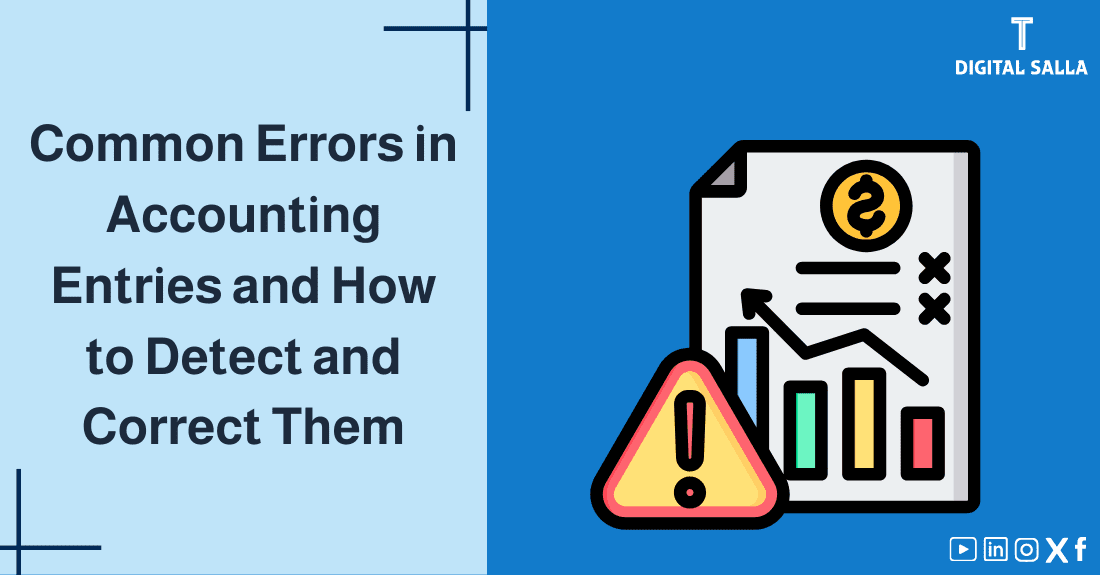Common Errors in Accounting Entries and How to Detect and Correct Them

Financial statements represent the culmination of a comprehensive accounting process, starting with the recording of economic events and ending with a summarized presentation of an entity’s financial position and performance. The accuracy of these statements hinges on the correctness of each step in the accounting cycle, beginning with accounting entries and the types of accounts used.
Despite the precision of modern accounting systems, the possibility of common errors in accounting entries remains, whether these errors stem from human oversight or shortcomings in applying accounting standards. Discovering and correcting these common errors in accounting entries promptly is paramount to ensure the reliability of financial information and the soundness of decisions based on it. In this context, the following sections will address common errors in the financial accounting cycle, how to avoid them, and how to rectify them.
What are Common Errors in Accounting Entries?
Common errors in accounting entries are diverse and can be categorized into the following main types:
- Errors of Omission:
- Definition: Occur when a financial transaction is completely forgotten or omitted from being recorded in the journal.
- Example: Failing to record a credit purchase of merchandise.
- Impact: Leads to an understatement of both total purchases and total creditors in the trial balance, thus not showing the entity’s accurate financial position.
- Errors of Commission:
- Definition: Occur when a financial transaction is recorded incorrectly, either in the selection of accounts or in the value of the amounts recorded.
- Types of Errors of Commission:
- Errors in Account Classification (Misposting): Selecting the wrong account to record the financial transaction, such as recording the purchase of furniture in the expense account instead of the fixed assets account.
- Errors in Amount: Recording the financial transaction with an incorrect value, such as recording a purchase transaction at 5,000 SAR instead of 500 SAR.
- Errors of Duplication: Recording the financial transaction more than once in the journal.
- Errors of Reversal: Recording a debit entry as a credit and a credit entry as a debit.
- Impact: These errors affect the accuracy of account balances in the ledger and trial balance, leading to misleading financial statements.
- Compensating Errors:
- Definition: A set of errors that offset each other, having an equal and opposite effect on both sides of the accounting entry.
- Example: Recording a purchase transaction at 500 SAR instead of 550 SAR, and recording a sales transaction at 500 SAR instead of 550 SAR.
- Impact: These errors are among the most difficult common errors to detect in accounting entries, as they do not affect the balance of the trial balance, but they lead to inaccurate financial statements.
- Posting Errors:
- Definition: Occur when accounting entries are incorrectly posted from the journal to the ledger.
- Types of Posting Errors:
- Posting to the Wrong Account: Posting the amount to an account other than the one specified in the entry.
- Posting the Wrong Amount: Posting the amount with a value greater or less than the value recorded in the entry.
- Posting to the Wrong Side of the Account: Posting a debit amount to the credit side or vice versa.
- Impact: These errors lead to inaccuracies in account balances in the ledger, affecting the balance of the trial balance and the accuracy of the financial statements.
- Errors of Principle:
- Definition: Occur when an accounting principle is applied incorrectly or an inappropriate accounting principle is used.
- Example: Recording the purchase of a fixed asset as an expense instead of capitalizing it.
- Impact: These are among the most serious common errors in accounting entries, as they lead to significant distortions in the financial statements and violate generally accepted accounting principles.
How to Detect Common Errors in Accounting Entries:
There are several ways to detect common errors in accounting entries, including:
- Trial Balance:
- The trial balance is a fundamental tool for detecting errors, as an imbalance between the debit and credit sides directly indicates an error in the accounting entries or their posting.
- Types of Errors Detected by the Trial Balance:
- Errors of Omission: Omitting an entire accounting entry will cause the trial balance to be unbalanced.
- Errors of Duplication: Duplicating an accounting entry will cause the trial balance to be unbalanced.
- Errors of Posting to the Wrong Side: Posting a debit amount to the credit side or vice versa will cause the trial balance to be unbalanced.
- Errors of Posting the Wrong Amount: Posting an amount with an incorrect value will cause the trial balance to be unbalanced.
- Types of Errors Not Detected by the Trial Balance:
- Compensating Errors: This type of error does not affect the balance of the trial balance.
- Errors in Account Classification: The trial balance does not reveal errors in choosing the appropriate accounts.
- Errors of Principle: The trial balance does not reveal errors in applying accounting principles.
- Periodic Review of Accounting Entries:
- Accounting entries should be reviewed periodically to ensure their accuracy and completeness. The review can be conducted by another accountant or through accounting software that provides error detection tools.
- Focus Points During Review:
- Ensure that all financial transactions are recorded.
- Verify the accuracy of account classification and the selection of appropriate accounts.
- Ensure the accuracy of the amounts recorded in both sides of the entry.
- Reconcile account balances with supporting documents.
- Reconciliations:
- Reconciliations are one of the most important internal control tools, comparing account balances in the ledger with other independent balances, such as bank statements and inventory records.
- Examples of Reconciliations:
- Bank Reconciliation: Comparing the bank account balance in the ledger with the bank statement.
- Inventory Reconciliation: Comparing the inventory balance in the ledger with the physical inventory count.
- Customer and Supplier Account Reconciliation: Comparing the balances of customer and supplier accounts in the ledger with statements sent by them.
- Using Accounting Software:
- Accounting software helps reduce common errors in accounting entries by automating the process of recording and posting accounting entries.
- Advantages of Using Accounting Software:
- Automatic application of the double-entry bookkeeping rule.
- Verification of the balance of entries before recording them.
- Provision of error detection tools.
- Generation of reports that help in reviewing accounts and detecting errors.
- Internal Audit:
- The internal auditor independently reviews accounting entries and financial transactions to ensure their accuracy and compliance with approved accounting policies and procedures.
How to Correct Common Errors in Accounting Entries:
The method of correcting common errors in accounting entries varies depending on the type of error and the timing of its discovery:
- Correcting Errors Before Closing the Financial Period:
- Errors of Omission: The omitted accounting entry is recorded in full.
- Errors of Commission:
- Error in Amount Only: The amount in the original entry is corrected.
- Error in Account Classification or Reversal: The incorrect entry is completely reversed, and then the correct entry is recorded.
- Posting Errors: The error is corrected directly in the ledger.
- Correcting Errors After Closing the Financial Period:
- Errors That Do Not Affect Net Income (Profit or Loss): These are corrected in the current period with a reversing entry of the incorrect entry, followed by recording the correct entry.
- Errors That Affect Net Income: These require a correcting entry in the retained earnings account to adjust the balance of earnings by the amount of the error.
Example of Error Correction:
- Situation: It was discovered that a credit purchase of merchandise for 1,000 SAR was mistakenly recorded in the debit side of the purchases account for only 100 SAR.
- Type of Error: Error in amount.
Correction Steps:
- Determine the Difference: 1,000 SAR (correct value) – 100 SAR (incorrect value) = 900 SAR.
- Record the Correcting Entry:
- 900 SAR Debit to Purchases Account (Dr.)
- 900 SAR Credit to Creditors/Accounts Payable Account (Cr.)
Note: All correcting entries should be clearly documented, explaining the reason for the adjustment and its date.
Importance of Timely Error Detection and Correction
- Ensuring Accuracy of Financial Data: Errors in accounting entries lead to inaccurate data, impacting the reliability of financial reports.
- Sound Decision-Making: Management and investors rely on correct financial data, so identifying and fixing errors helps in making the right decisions.
- Preventing Fraud: Uncovering errors quickly can prevent any financial manipulation or fraud from occurring.
- Improve Internal Control Efficiency: Identifying errors leads to reviewing internal controls to prevent repeating the same error
Conclusion:
Common errors in accounting entries are a possibility, but it is crucial to detect and correct them as quickly as possible to ensure the accuracy and reliability of financial data. By following sound internal control procedures, using modern accounting software, and providing continuous training to accountants, common errors in accounting entries can be minimized, resulting in financial reports that truly reflect the entity’s financial reality. Detecting and correcting common errors in accounting entries is the responsibility of every accountant and financial auditor to ensure the integrity of the accounting system and the accuracy of financial reports.
